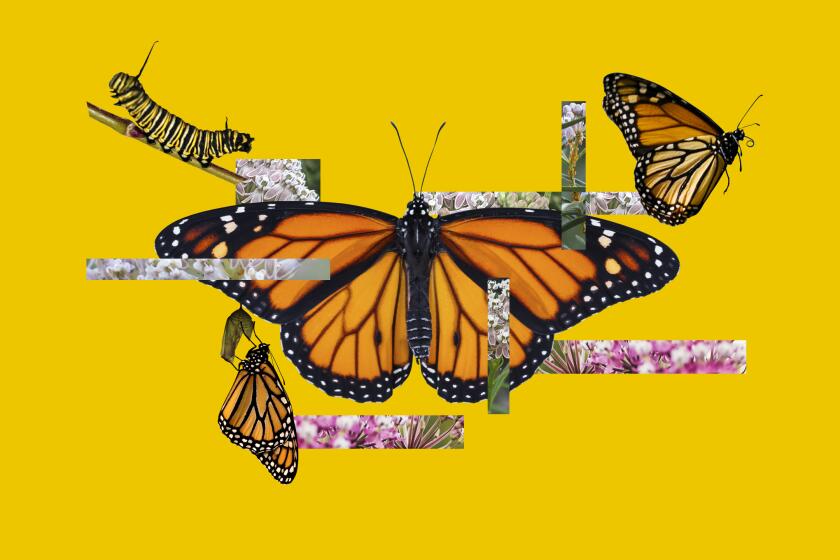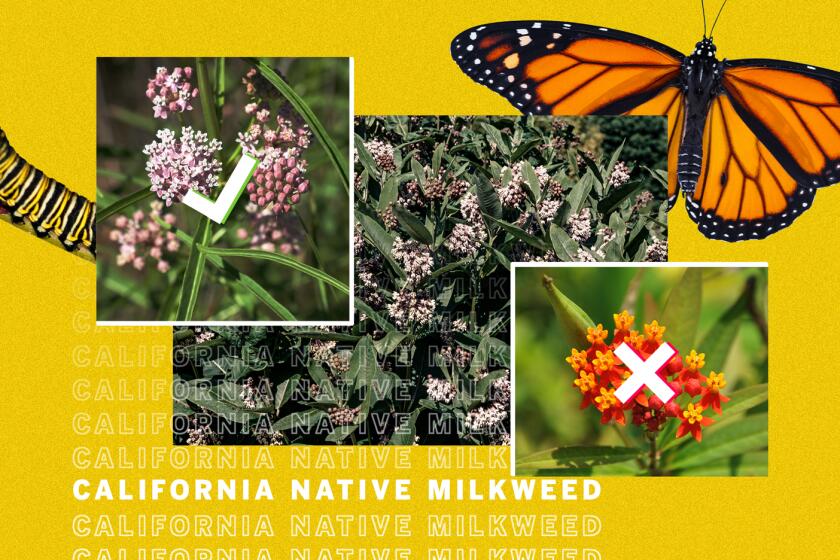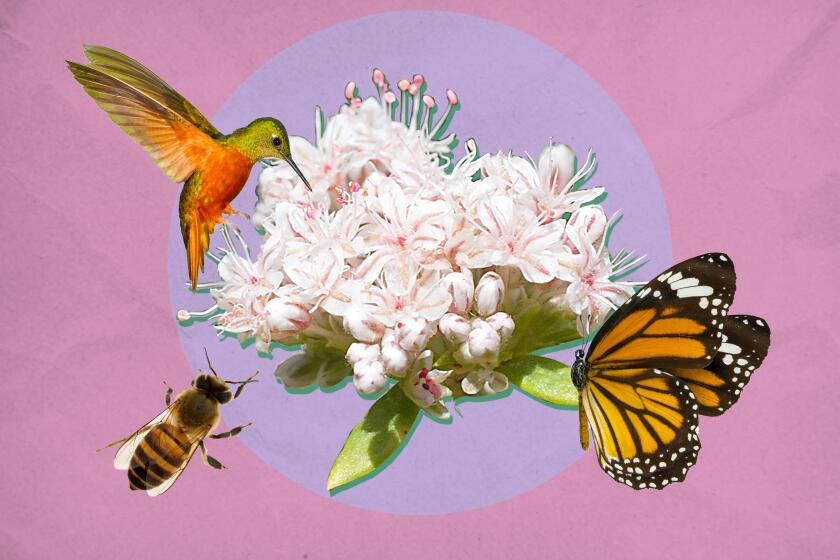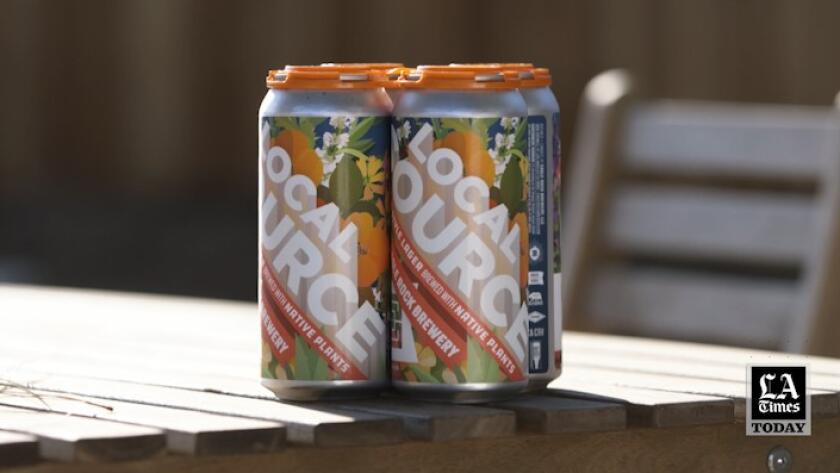L.A.’s newest craft beer is made with native plants and blooms: Here’s how to try it
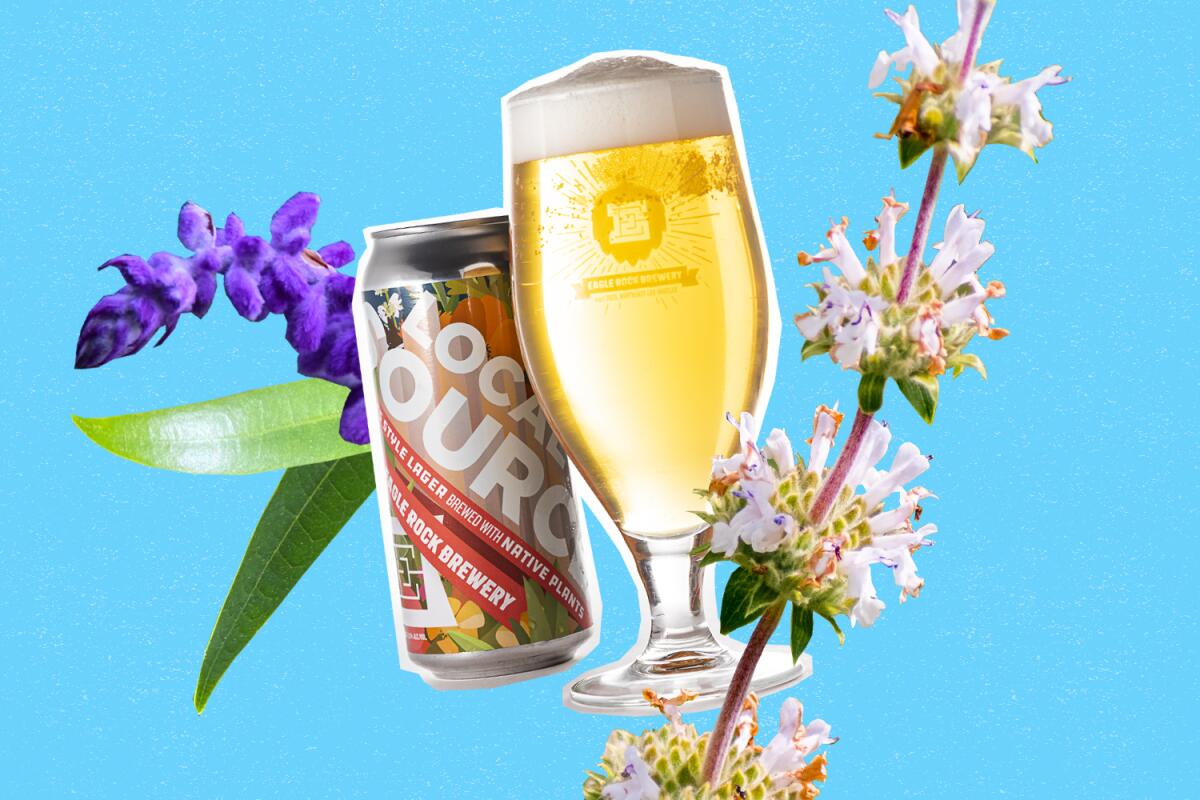
So ... some geeks walk into a bar to talk about their obsessions — native plants, pollinators and farming — and discover the guy who owns the place is a kindred spirit and totally into inventing craft beers. So they put their heads together and come up with a new brew to honor their passions, flavored with three highly fragrant native plants — woolly bluecurls, black sage and California laurel — that are as bee- and butterfly-friendly as they come.
And, really, that’s pretty much how Eagle Rock Brewery’s new Local Source beer was created, with the help of the Theodore Payne Foundation’s native plant experts. And now they’re having a public party at the brewery on Sunday to spread the word about the importance of building habitat with native plants to help support the beneficial insects and animals that pollinate our food.
In other words: While you’re learning, you can sample some really tasty beer.
“We’re calling it a Pollination Party because it’s a pollination of all our interests,” said Evan Meyer, director of the Theodore Payne Foundation. And this party is open to anyone who wants to come. It’ll be held from noon to 5 p.m. at the Glassell Park brewery.
Monarch butterfly populations are endangered, to the point that the 1.2 million Western monarchs counted in 1997 plummeted to fewer than 2,000 by 2020. Here are ways we can help them survive.
It was the foundation’s nursery sales manager, Flora Ito, a craft beer fan and Eagle Rock Brewery regular, who proposed the marriage of native plants and beer.
Theodore Payne was looking for a unique way to celebrate its 60th anniversary in 2020, and during a brainstorming meeting, Ito suggested making a beer from native plants. “They said, OK, who knows a brewery?‘” Ito recalled, “so I raised my hand again and said, ‘There’s this local brewery that really supports the community ... and I’m a frequent customer.’”
When approached, Eagle Rock Brewery’s Jeremy Raub was instantly interested. Raub and his fellow owners — wife Ting Su and father Steven Raub — had already started a Day Trip Series of beers that celebrate outdoor wonders around L.A. The brown ale 2 North heads into the San Gabriel Mountains, and a session IPA, Mosaic Canyon, is named after the famous canyon in Death Valley, so a beer featuring L.A.’s native flora fit right in.
Raub and his fellow brewers made a couple of trips to the Theodore Payne Foundation’s nursery in Sun Valley, touring its native plant demonstration gardens and the growing sheds where seeds and seedlings are produced for habitat restoration in Southern California as well as sales to landscapers and yard owners. Raub and his crew spent a few hours sniffing and tasting various plants and gave the foundation staff some ideas about what flavors work well together.
The foundation’s experts winnowed their choices to 15 aromatic plants and sent them to Raub and his crew, who narrowed their choices to three.
Actually, Raub said, he knew almost immediately that the base for the beer would be black sage (Salvia mellifera), with its intense savory and sweet floral tones.
Native milkweed plants — the kind good for butterflies — are coming out of dormancy and starting to sprout, so be patient. Southern California gardeners should be able to buy narrow-leaf milkweed and perhaps a few other less-well-known native milkweeds starting in mid-April.
But creating a flavorful beer, especially a lager, is like writing music, with its bass, high and middle notes, Raub said.
California laurel (Umbellularia californica) became the bass notes to keep sage from overwhelming with its high woodsy, citrusy aroma, he said. “It gave the flavor a lot of depth.”
Surprisingly, though, the flavor that really shines in this 5.2% helles-style lager is woolly bluecurls (Trichostema lanatum), a showy member of the mint family with rosemary-type leaves and staff-like blooms that look like clusters of tight purple curls. The aroma is both earthy and fruit-punch sweet — Ito says it almost smells like bubble gum to her — but paired with the laurel and black sage, it provided a faint but refreshingly fruity aftertaste.
So, yes, these fragrant native blooms make a delicious lager, but they’re also very popular with pollinators, such as bees, butterflies and hummingbirds.
Just take a sniff, said Raub. “You can see why the insects crowd around these plants.”
Once the brewers had their “notes,” deciding on the type of beer was relatively easy, Raub said. “We didn’t want something super heavy with these floral notes, and with IPAs the hops can dominate all the flavors.”
Plus, Meyer said, they liked the idea of a light but flavorful beer that would be perfect for drinking on a hot day, after working outside.
The new wave in landscaping is building habitat by growing native plants, but you don’t need a yard to promote biodiversity. Hummingbirds, butterflies, bees and other pollinators are happy to dine on native plants growing on balconies or patios.
“We didn’t know it would be a lager at first,” said Raub, “but we wanted something you’d want to drink after gardening or hiking, something refreshing, crisp and light, and the helles-style lager tends to be a little more flavorful.”
It’s also a beautiful golden color that looks as refreshing as it tastes, Meyer said.
Raub said they experimented with how to add the native plants — boiling the flavors down or just adding them fresh. Ultimately, they added dehydrated plants to the boil kettle before those contents were sent to fermentation, andthey finished the beer with a tincture of fresh woolly bluecurls that allowed them to adjust the flavor until they got it just right.
Local Source is available at the brewery (four-packs of 16-ounce cans are $14.20) and at independently owned liquor stores in Southern California that specialize in craft beer.
And, of course, there will be plenty for purchase at the Pollination Party on June 13 at the brewery, 3056 Roswell St.
Admission is free, as are pop-up booths about bees, butterflies, wasps and other beneficial insects native to Los Angeles (staffed by Lisa Gonzalez, assistant collections manager of the Natural History Museum), why beneficial insects are critical to producing our crops (staffed by Eric Tomassini and Ali Greer, co-owners of Avenue 33 Farm in Lincoln Heights, and the importance of creating habitat with native plants to support insects, birds and other local animals (staffed by Theodore Payne Foundation members.)
Avenue 33 Farm also will be selling tomato, bean, cucumber and zucchini seedlings. Theodore Payne will be selling native-plant swag, including $65 monarch butterfly kits that include everything you need to grow monarch-friendly gardens. The South Asian food truck Jungli will also be on site.
Meyer strongly encourages visitors who plan to drink to hire a ride to and from the event, and not only because that will mean you can drink without transportation worries: Parking will be especially tight.
Watch L.A. Times Today at 7 p.m. on Spectrum News 1 on Channel 1 or live stream on the Spectrum News App. Palos Verdes Peninsula and Orange County viewers can watch on Cox Systems on channel 99.
More to Read
Sign up for The Wild
We’ll help you find the best places to hike, bike and run, as well as the perfect silent spots for meditation and yoga.
You may occasionally receive promotional content from the Los Angeles Times.
